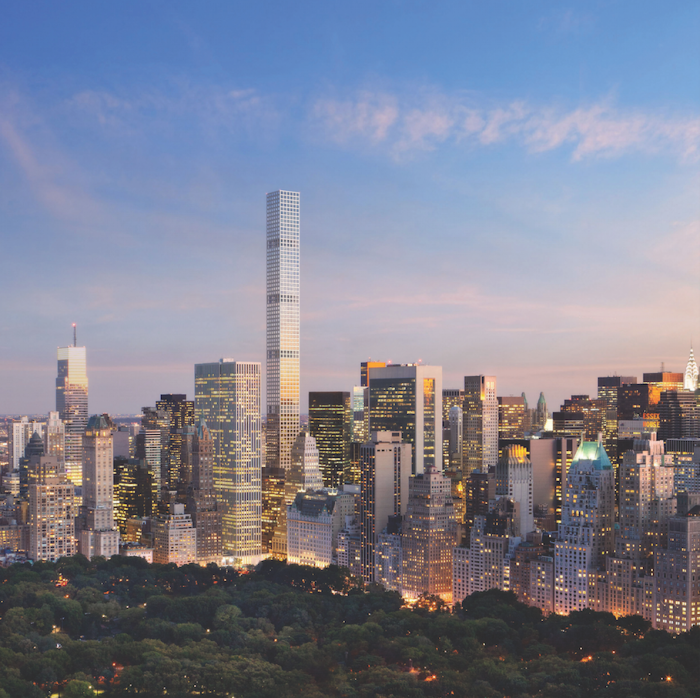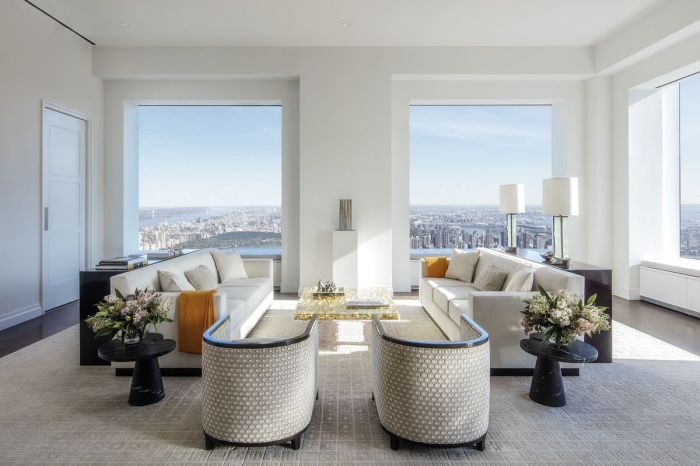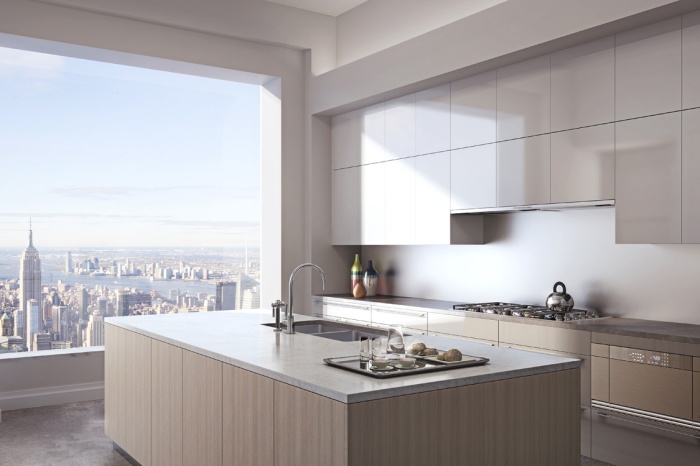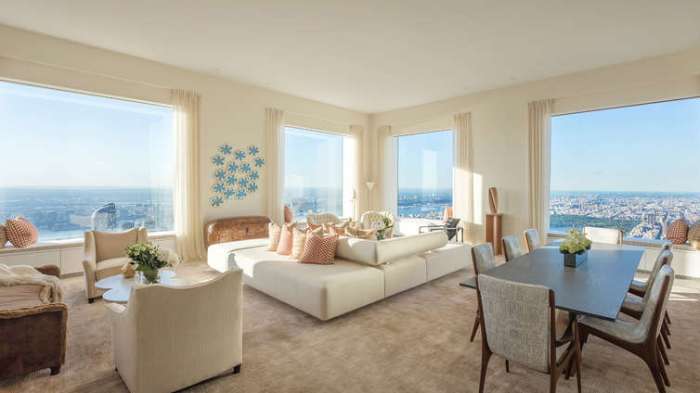 New York has always attracted wealth and been the home of some of the most expensive real estate on earth. But right now there’s a luxury property boom in Manhattan in the form of skyscrapers with the likes of 432 Park Avenue setting new standards. So why is this happening now, who’s buying and what does it mean for the city?
New York has always attracted wealth and been the home of some of the most expensive real estate on earth. But right now there’s a luxury property boom in Manhattan in the form of skyscrapers with the likes of 432 Park Avenue setting new standards. So why is this happening now, who’s buying and what does it mean for the city?
At 10.30am on the brightest and crispest of New York autumn mornings, the view from the upper floors of 432 Park Avenue is so elevated and so clear you can actually detect the curvature of the Earth.
You can see as far as Connecticut to the north, way past Brooklyn and Queens to the Atlantic Ocean to the east, while southern-facing windows overlook every part of Manhattan below 56th Street. And in the same way that tilt-shift photography makes everything look like a model, so being up here makes the city below look like miniatures of the huge buildings they actually are. The apartment takes up the entire floor, so it means you get 360° views out of huge 10-foot-by-10-foot windows. It is, however, a view that will cost you $95 million.
That’s a price as breathtaking as the view, although it could be argued it’s about the same as a Mark Rothko painting and cheaper than a Picasso. Unlike a Picasso the image changes with the seasons and unlike a Rothko you can actually tell what you’re looking at. And you’re not just looking at something, you’re looking down on it, and what you’re looking down on is one of the most iconic pieces of land on the planet – Manhattan. And right now it’s in the midst of a luxury property boom.
Amid this new scramble to build incredible high-end apartments, 432 Park Avenue is the big, grand statement, which is, as The New York Times pointed out, “redefining the aesthetics of affluence in a second Gilded Age”. It’s currently the tallest residential building in the Western Hemisphere – a lean, 426-metre tower on Park Avenue at 56th Street.

Designed by Uruguayan architect Rafael Viñoly, the tower has 106 luxury condominium complexes that either occupy a full floor or half-floor, 12-and-a-half-foot ceilings, private elevator landings, heated bathroom floors, swimming pool, screening room and gym. It even has its own top-class restaurant on-site just to cater to the residents, so if you don’t live here, you won’t ever be able to get a reservation.
Developed by CIM Group and Macklowe Properties, the man behind the building is legendary real estate developer Harry B Macklowe, one of the characters of New York real estate and a smart businessman. He owns around 12 million square feet of office space in the city and made his name in 2003 when he paid the Trump Organization and Conseco $1.4 billion for Manhattan’s General Motors Building. Today the building is worth more than double that. But 432 Park Avenue – on the site of the former Drake Hotel – is one of many luxury towers being built (albeit arguably the most high-end) and they’re not just tall homes, they’re monuments to modern wealth.

Perhaps significantly, according to one report, small studios to be used as staff quarters at 432 Park Avenue are going for between $1.53 million to $2.8 million. You can only buy one if you’re already a resident and just need somewhere for the nanny (or whoever) to be on hand. Other new properties One57 and 15 Central Park West also have them, and it’s actually these staff quarters that have seen the biggest increase in price since initial launch because they’re surprisingly hard to find. Most staff quarters in older buildings were converted into offices or extra bedrooms many years ago, but it seems that wealthy residents who have staff are on the rise once more.
So why is this high-end property boom happening in Manhattan right now? Richard Wallgren, vice president of sales and marketing for Macklowe Properties, is the man charged with selling the apartments to the tiny sliver of the global population who can afford one. The fraction of the one per cent – those who almost certainly can buy without having to raise the cash by doing anything as prosaic as selling their current home.
“I think it’s just the general globalisation of the world economy and New York in particular has been the hub for wealth for many, many generations,” he says. “It was the hub for American wealth initially, the Fords from Detroit or the Carnigies, they all had major houses and apartments in New York as a symbol of their wealth and achievement. And that now gradually has expanded to other parts of the world, beginning with England, with France, with Italy, many of those scions of industry from all of those countries have had apartments in New York. And as further industrialisation and wealth creation has occurred in Russia, China, India and South America, it’s just a natural progression of wealth creation.”
At the last count by Forbes, there were 1,826 billionaires in the world, the highest number ever recorded. The 2015 list included 290 newcomers to the “three comma club” and no matter what you think about the distribution of wealth or the one per cent, it’s clear that properties like this are becoming increasingly viable.
Asked to describe the sort of person who buys the property Wallgren is in little doubt: “Our buyer has New York, has East Hampton, has Aspen, or maybe it’s not Aspen, maybe it’s Vale, and then of course they never go to Kennedy Airport, they go to Teterboro Airport with their private planes. They also have a yacht, they have a helicopter and an apartment in London. They may be Indian by birth, but they live in London and they have a country home in the South of France and a city home in New York – because they probably have some type of business operations in the United States.”
The über-wealthy are now global citizens. Those who have bought include the Indian owner of a pharmaceutical company, a Greek in the shipping industry, a Turk who owns a major conglomerate; the ultra rich are from all over, but it seems that Manhattan and London are primarily feeling the effect of their wealth. Anywhere else is an addition, as Wallgren points out: “Miami’s become very popular, but most people of wealth who are considering Miami, probably already have New York. It’s more of a playground as opposed to a sort of grown up wealth. Anyway, the super wealthy citizen goes not to Miami, but to Palm Beach.”

The effect on Manhattan has been significant. In late 2003 the average price for a Midtown condo was around $666 per square foot, but by the start of 2015 it was $2,395. The increase of 260 per cent is partly down to demand, but also the arrival of new luxury apartments that are commanding big fees. And there’s no great shortage of consumers. The buyer of that $95 million penthouse at 432 Park Avenue is a Saudi Arabian retail magnate, Fawaz Al Hokair – his new penthouse cost just over $11,500 per square foot. The average asking price in the building is around $7,000 per square foot.
Strangely, one of the driving factors for sales has not been the world-class entertainment and dining, investment, nor that Manhattan is a global centre of business, but the fact that some of the best schools in the world are on America’s East Coast.
The Chinese lady in big expensive looking shades being given the tour just ahead of us is apparently looking to buy a place so she can be near her children who are starting at a nearby University. She’s not the only one.
“Access to good education is now one of the drivers at the forefront of a buyer’s decision,” Wallgren says. “I think as our school systems have continued to improve and expand, we’re seeing a situation, particularly from China and the Middle East, where boarding schools and the private schools – Andover, Exeter, Choate and so on – are very appealing to super high-end purchasers and families. If you look on a map it’s very handy to be in New York and have your children meet with you on holidays and weekends.”

It may seem strange that the battle to get children into top schools is driving a luxury property boom but Wallgren met with one buyer simply because he wanted to get his very young children acclimatised to the American way of life, with a view to eventually getting into one of Manhattan’s prestigious private schools and eventually gaining a college education in the country. “Some of them are coming to New York because their children are going to places like Harvard, and they want a family place to meet as the children go to school in America.”
The city has always drawn in the wealthy, but there’s been a recent shift. Speaking to Portfolio in his Manhattan office, architect Viñoly is more than aware of the explosion of density and growth as increasing numbers of people move to cities. “If you remember the ’70s, then everyone was leaving and going to the country, well, everybody is back!” he says.
“And this town is about verticality, it’s in the DNA of the city and New York has proven since its inception that it can absorb that in a brilliant way. People talk about the Manhattanization of other cities but whoever uses this term misses the point because this is impossible to reproduce. It’s a tiny island that doesn’t have any problem of sprawl and it has its energy. Manhattan has a capacity to present itself as an urban object as opposed to a typical city.”
Viñoly points out that the top of the Empire State Building generates more money than the rest of the building combined, simply through people visiting there to enjoy the view from the top. This is another reason the new luxury properties are being built so tall – the value of the view. While the typical ratio for tall buildings (width to height) is 11:1 his building is nearer to 19:1 with each floor a perfect square stacked upon the next. The openings you see every eleven floors allow the wind to go through and diminishes the vortex effect, which is something that pushes and moves the building – like an airplane wing creating pressure on one side.
It was an economic decision as well as a design one. In order to have the views you have to be tall, and because there are tall buildings already there new developments need to grow even taller to create that prized view.
Deborah Berke is the design architect for 432 Park Avenue, responsible for interiors, whose design brief was simply “no set budget, make it look fantastic” but she adds “I honestly think that the two great luxuries in urban life – beyond obvious ones like the size and the location of your place – are natural light and distant views, because not everybody has them. In the city, natural light and distant views are hard to come by on dense streets.
“New York is a skyline-driven city – and if the image of Paris is the Eiffel Tower then the image of New York is the skyline – being part of that you have these two symbols of luxury, light and view, and then you’re a part of something that is signature New York.”
The recent new money, however, has not always found it easy to buy in New York. Like the social difference between East and West Egg in The Great Gatsby, so there’s still an element of that in Manhattan, with the Upper West Side being the home of old money while these modern luxury condominium towers represent the home of new money. There’s also an interesting reason for that: the co-op system.
Many other places around Central Park were created in the last Great Prosperity building boom of the late 1920s and like the famous Dakota building, have a co-op that have to approve you before you’re allowed to move in. The likes of Cher, Billy Joel, Madonna, Carly Simon, Alex Rodriguez and more recently Judd Apatow and Téa Leoni have all reportedly been rejected from the Dakota. And that’s just one building.
As Wallgren points out: “The structure of the co-op makes it difficult for many global residents to tolerate the process, because there’s complete transparency in terms of your rent condition, your taxes and so on. You’d need several letters of recommendation and those letters are key, in terms of the right schools, the right synagogues, the right churches, tennis clubs, golf clubs, all of those things. Obviously in a condominium it’s not necessary. You can’t shield the identity of your ownership in the co-op, whereas you can in a condominium and that’s enormously appealing to many international residents.”
Now that it’s easier for the ultra-wealthy to move into prime areas of the city, these buildings are proving hugely profitable and there’s a growing market for ultra luxury in a place with hugely limited land. It’s spreading, and the part of Harlem along Central Park North looking downtown has now become much more expensive, so there is a further gentrification of Manhattan, but the prime spots are increasingly sought after.
The neighbourhoods that people want to be in are tightly defined like Park Avenue, Fifth Avenue and the area ringing Central Park and there are very few development sites remaining and that’s one of the reasons why prices have continued to increase – the wealthy community wants to be in very prescribed neighbourhood. They want to “ring the park” and that means that land costs are extremely high and development sites are rare because they’re historic districts, or it’s already been developed by a co-op.
Plus, no-one wants to be a standalone at $50 million if everything else trades for $20 million. And that’s what’s significant about 432 Park Avenue – all apartments are expensive. They sustain each other. “One of the adages of real estate”, Wallgren says “is you don’t want to be the most expensive on the block and have everything else be considerably lower, because the lower will pull you down as opposed to being sustained.”
The prevailing idea that these towers will be bought up by foreigners who will never use it as their home holds some weight, but Portfolio is told that over half the buyers are based in America despite varying nationalities. In addition, Viñoly says, “There are not a lot of foreigners if you look at the roster of owners for 432, this is an important thing in terms of addressing what you may believe.” And the idea that it will never be more than a quarter full?
“There’ll be periods in January, February, March, or in July and August, where there’ll be few people here or they’re here for a few days on their way to somewhere, although we do have people that regard this as their primary residence,” Wallgren says.
“There’ll be peak areas of the year where it will be fully occupied, particularly during holiday season or during the art auctions, which are extremely popular at Sotheby’s, or Christie’s, depending on what is up for sale – contemporary, classic, watch collections, these people are significant art collectors.
The ultra-rich are collecting art now more than ever, and the earlier comparison of the apartment’s price to a Rothko or Picasso is valid. For some owners, the apartment itself (even at these prices) will be overshadowed by the value of the art hanging on the wall and the large wall spaces were created intentionally by Berke for the placement of art. It could turn out that – unbeknown to individuals in each apartment or the outside world – this building as a whole will come to house a collection of fine art that surpasses that of many galleries.
And that’s the world these people live in. Some have pointed out that throughout history, the rich have always built big towers to get away from the poor, but this new extravagance is something different and happening in such quantity as to be notable of the times we are now living in. Although the architect himself points out that “at the end of the day everyone has to come down and walk on the street”, these towers are a whole new level of design, luxury and price. And it’s something that is only going to continue.
“Because the land costs are so expensive in Manhattan and continuing to appreciate,” Wallgren states, “that $95 million could very easily become $105 million before you know it. It’s not long ago when it was unusual for an apartment to trade for $25 million – these days, that’s just a yacht.”
He smiles and shrugs, “People are getting comfortable with these new numbers.”
For Portfolio magazine


